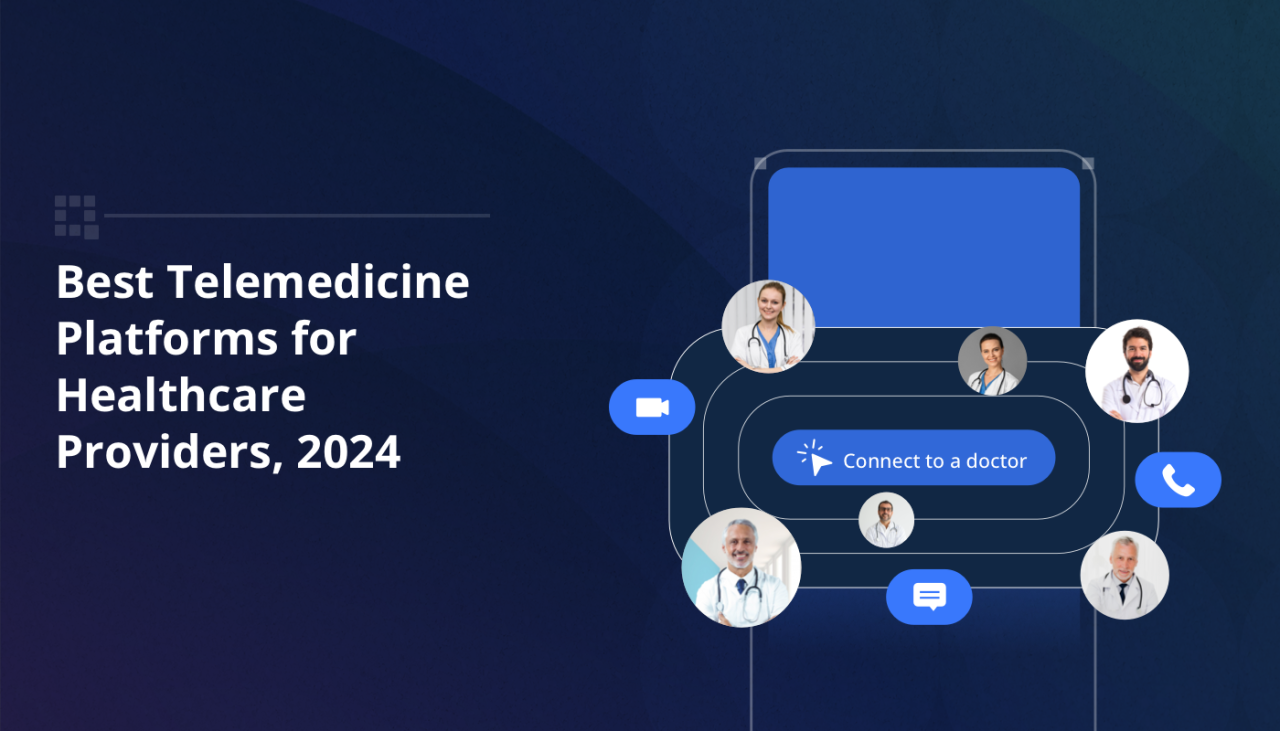General
Top Telehealth Platforms for Global Patients: A Comprehensive Guide

Embark on a journey through the world of telehealth platforms for global patients, diving into the benefits, key features, and comparisons of the top platforms available today.
Overview of Telehealth Platforms
Telehealth platforms for global patients are digital healthcare solutions that allow individuals to consult with healthcare providers remotely, using technology such as video calls, messaging, and virtual appointments. These platforms offer a convenient and efficient way for patients to receive medical advice, diagnosis, and treatment without the need to visit a physical clinic or hospital.
Benefits of Using Telehealth Platforms
- Convenience: Patients can access healthcare services from the comfort of their own homes, saving time and eliminating the need for travel.
- Accessibility: Telehealth platforms provide access to healthcare professionals regardless of geographic location, making healthcare more inclusive and available to a wider population.
- Cost-effective: Virtual consultations are often more affordable than in-person appointments, reducing overall healthcare costs for patients.
- Time-saving: With telehealth platforms, patients can avoid long wait times at clinics and receive timely medical advice and treatment.
Key Features of Top Telehealth Platforms
- Secure Messaging: Patients can communicate with healthcare providers securely and conveniently through messaging features.
- Video Consultations: Platforms offer real-time video consultations for a more personalized interaction between patients and healthcare professionals.
- Electronic Prescriptions: Top telehealth platforms allow doctors to prescribe medications electronically, making it easier for patients to access their prescriptions.
- Health Record Access: Patients can view and manage their health records online, ensuring continuity of care and easy access to medical information.
Top Telehealth Platforms Comparison
In the evolving landscape of telehealth, several platforms have emerged to cater to global patients. These platforms offer various features, pricing models, and user experiences. Let's compare some of the top telehealth platforms available today.
1. TeleDoc
TeleDoc is a popular telehealth platform that offers virtual consultations with healthcare providers. They have a subscription-based pricing model that allows patients unlimited access to doctors for a monthly fee. The user interface is user-friendly, with easy navigation and secure messaging features.
2. Doctor on Demand
Doctor on Demand is another leading telehealth platform that provides video consultations with medical professionals. They charge per visit, making it convenient for patients who prefer a pay-as-you-go model. The platform has a simple and intuitive interface, making it easy for patients to schedule appointments and communicate with doctors.
3. HealthTap
HealthTap offers a range of telehealth services, including virtual visits, online chat with doctors, and access to medical information. They have a freemium pricing model, where patients can access basic services for free and pay for additional features. The platform has a modern interface with AI-powered chatbots for quick responses to medical queries.
4. Amwell
Amwell is a telehealth platform that connects patients with healthcare providers for virtual consultations. They offer both insurance-based and direct-to-consumer pricing options, catering to a wide range of patients. The platform has a user-friendly interface with features like appointment scheduling and prescription refill requests.
5. Teladoc Health
Teladoc Health is a comprehensive telehealth platform that offers virtual care services for various medical conditions. They have a membership-based pricing model, providing patients with 24/7 access to healthcare professionals. The platform is known for its secure and easy-to-use interface, ensuring a seamless telehealth experience for patients.
Accessibility and Language Support
In the realm of telehealth platforms for global patients, ensuring accessibility and language support are crucial aspects that contribute to the overall quality of care provided.
Accessibility for Patients from Various Regions
Telehealth platforms employ various strategies to ensure accessibility for patients from different regions:
- Utilizing user-friendly interfaces that are easy to navigate regardless of the patient's location.
- Offering multiple language options to cater to diverse patient populations.
- Providing technical support to assist patients in accessing and utilizing the platform effectively.
- Ensuring compatibility with different devices such as smartphones, tablets, and computers for convenient access.
Importance of Language Support
Language support plays a vital role in telehealth platforms for global patients:
- Facilitates effective communication between healthcare providers and patients, leading to better understanding of medical conditions and treatment plans.
- Enhances patient engagement and satisfaction by offering services in the patient's preferred language.
- Promotes inclusivity and cultural competency in healthcare delivery, fostering trust and rapport between providers and patients.
Overcoming Language Barriers
Telehealth platforms implement various strategies to overcome language barriers and provide quality care:
- Utilizing real-time language interpretation services to facilitate communication between patients and providers.
- Offering translated educational materials and resources to ensure patients have access to relevant information in their preferred language.
- Training healthcare providers in cultural competence to effectively communicate and engage with patients from diverse linguistic backgrounds.
- Collaborating with multilingual staff or interpreters to assist patients during virtual consultations and appointments.
Security and Privacy Measures

When it comes to telehealth platforms, ensuring the security and privacy of patient data is of utmost importance. Let's delve into the security measures, privacy policies, and compliance with international regulations implemented by top telehealth platforms to protect global patients.
Security Measures
- Encryption protocols: Top telehealth platforms utilize advanced encryption techniques to secure all communication and data exchanges between patients and healthcare providers.
- Multi-factor authentication: Implementing multi-factor authentication adds an extra layer of security to verify the identity of users accessing the platform.
- Regular security audits: Conducting regular security audits helps identify and address any vulnerabilities in the system to prevent potential cyber threats.
Privacy Policies
- Data confidentiality: Telehealth platforms have strict privacy policies in place to ensure that patient information is kept confidential and only accessed by authorized personnel.
- Patient consent: Platforms require patient consent before sharing any personal health information with third parties to maintain patient privacy.
- Data retention policies: Clear guidelines on data retention help in protecting patient privacy by ensuring that data is not stored longer than necessary.
Compliance with International Regulations
- HIPAA compliance: Many telehealth platforms adhere to the Health Insurance Portability and Accountability Act (HIPAA) regulations to safeguard patient health information.
- GDPR compliance: Platforms also comply with the General Data Protection Regulation (GDPR) to protect the personal data of patients located in the European Union.
- ISO certifications: Some platforms obtain ISO certifications related to data security and privacy to demonstrate their commitment to maintaining high standards of protection.
Integration with Healthcare Systems
Telehealth platforms play a crucial role in modern healthcare systems by integrating seamlessly with existing infrastructure to provide efficient and accessible care to patients worldwide. This integration allows for improved communication between healthcare providers and patients, leading to better health outcomes and overall patient satisfaction.
Interoperability Features
One of the key aspects of top telehealth platforms is their interoperability features, which enable them to communicate effectively with various healthcare systems and electronic health records (EHRs). This seamless integration allows for the exchange of important patient information, such as medical history, test results, and treatment plans, between different platforms and providers.
By ensuring interoperability, telehealth platforms can streamline the care delivery process and enhance coordination among healthcare professionals.
Successful Integrations
Several examples demonstrate the successful integration of telehealth platforms with healthcare systems, resulting in improved patient care. For instance, some platforms have partnered with major hospitals and clinics to offer virtual consultations, remote monitoring, and telemedicine services. These collaborations have enhanced access to care for patients in remote areas, reduced wait times for appointments, and enabled better follow-up care for chronic conditions.
Additionally, integrated telehealth systems have shown to increase patient engagement, adherence to treatment plans, and overall satisfaction with the healthcare experience.
Closing Summary
In conclusion, the landscape of telehealth platforms is ever-evolving to cater to the diverse needs of global patients, ensuring accessibility, security, and seamless integration with healthcare systems. Stay informed and empowered in managing your healthcare journey with these innovative platforms.
Detailed FAQs
How do telehealth platforms ensure accessibility for patients worldwide?
Telehealth platforms use various tools such as multilingual interfaces, telecommunication technologies, and user-friendly designs to ensure global accessibility.
What pricing models do top telehealth platforms typically offer?
Top telehealth platforms often provide subscription-based models, pay-per-visit options, or insurance coverage for virtual consultations.
How do telehealth platforms address language barriers for global patients?
Platforms utilize language translation services, offer multilingual support, and provide culturally sensitive care to overcome language barriers effectively.
What security measures are implemented by telehealth platforms to protect patient data?
Telehealth platforms employ encryption, secure data storage, regular security audits, and compliance with strict data protection regulations to safeguard patient information.
How do telehealth platforms integrate with existing healthcare systems globally?
Integration is achieved through electronic health record (EHR) systems, interoperability standards like HL7, and APIs that enable seamless data exchange between platforms and healthcare providers.

-

 General8 months ago
General8 months agoBest Insurance Lawyers Near Me for Claim Disputes: Your Ultimate Guide to Legal Assistance
-

 General8 months ago
General8 months agoNavigating Insurance Claim Denial Lawyers Near Me
-

 Design8 months ago
Design8 months agoOutdoor Design Essentials for a Holistic Lifestyle: Integrating CRM Automation for Lifestyle eCommerce Brands
-

 General8 months ago
General8 months agoWellness Lifestyle and Outdoor Living Integration Tips: Modern Farmhouse Exterior Ideas for Luxury Lifestyle Homes
-

 General8 months ago
General8 months agoThe Best Business Insurance for Interior Designers: A Comprehensive Guide
-

 General8 months ago
General8 months agoCrafting a Comprehensive Guide to Medical Malpractice and Insurance Settlement Law Firms
-

 General8 months ago
General8 months agoHow Exterior Renovations Affect Your Home Insurance Rates: A Comprehensive Guide
-

 General7 months ago
General7 months agoDigital health trends transforming Asia in 2025: A Glimpse into the Future of Healthcare




